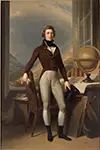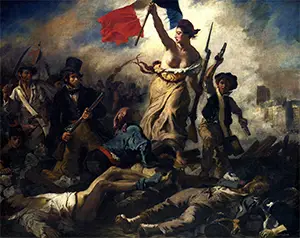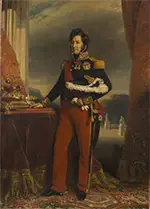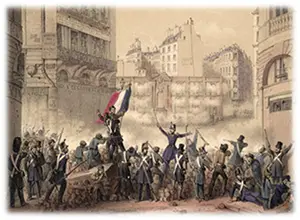The French King Louis Philippe
Louis Philippe was the last king to rule France. He styled himself King of the French and came to the throne as a result of the July Revolution of 1830. Another revolution, 18 years later, forced him to give up his throne. He was born on Oct. 6, 1773, at the Palais Royal in Paris. He was the oldest of five children of Louis Philippe II, the Duke of Orléans, and Louise Marie Adéaïde of Bourbon. 
Louis Philippe was 16 when the French Revolution began. He joined the Jacobin Club and became a Freemason. He served in the French Army and fought in the War of the First Coalition, seeing action at the Battles of Valmy, Jemappes, and Neerwinden. He fled the country when violence ruled the land and spent time in several other European countries and in the United States, staying for a time with George Washington at Mount Vernon. Louis Philippe was a wanted man and so assumed an alias, living off the land at times. At one point, he was teaching French and math at a school at Reichenau, Switzerland. Like so many other nobles who remained in France, his father was a victim of the guillotine. Louis Philippe went to England in 1800 and remained there until he thought it safe to return to France. He wed Princess Maria Amalia of Naples and Sicily, the daughter of King Ferdinand I of the Two Sicilies, in the Italian city of Palermo on Nov. 25, 1809. Louis Philippe and Maria had 10 children together. Five years later, when Emperor Napoleon Bonaparte abdicated for the first time, Louis Philippe's cousin became King Louis XVIII. Louis Philippe found himself welcome at the royal court, and this continued under the reign of Louis's successor, Charles X. Philosophically, Louis Philippe agreed more with Louis XVIII about the need for equality and tolerance and less with Charles, who preferred a return to absolutism. Despite support from a number of rich nobles, Charles found himself increasingly out of favor with the rest of the population. Parliamentary elections in 1827 resulted in a majority opposed to the king's plans. He went through a series of prime ministers as well, the last one being Jules de Polignac, who kept Parlement on the sidelines until March 1830. As well in France as the 19th Century progressed rose a nascent industrial revolution. Mechanization replaced human hands in several industries, putting people out of work. A series of terrible grain harvests in the late 1820s exacerbated the problem for many people who lived hand-to-mouth. A mere three weeks into the new parliamentary session in 1830, the king called for elections, which resulted in a large number of people opposed to the king and his policies and actions. In the ensuing elections, in June, a majority were again in opposition to what the king wanted. On July 6, Charles suspended the constitution. On July 25, he issued the Saint-Cloud Ordinances, which dissolved the Chamber of Deputies, called again for new elections, restricted conditions for voting and representation, and did away with freedom of the press. The streets of Paris swoon swelled with protesters, armed with rocks, bottles, and whatever else they had to hand. They formed barricades and resolved to stay until their demands were met. They took control of the Hôtel de Ville, the town hall and center of the city's government, and rang the bell of Paris. 
By July 29, 30,000 people stood behind 4,000 barricades in Paris. The king refused to talk to the protesters, and Marmont got no reinforcements. The Swiss Guard surrendered the Louvre without a fight, and the protesters seized the Tuileries Palace as well. The calls for Charles to go were not confined to Paris. Protests took place elsewhere; all had the same result. Charles abdicated the throne on Aug. 2, 1830. Taking the throne on August 9 was the people's choice, Louis Philippe, who had been Lieutenant General of the Kingdom. Charles had named his grandson Henri, Duke of Bordeaux as his successor, but the people of France had other ideas. The new leader proclaimed himself King of the French, embraced the tricolor flag, and agreed to be ruled by a constitution. Charles, meanwhile, left France altogether, landing back in the U.K. He did not return. (He died in what is now Slovenia in 1836.) A newly minted constitution was known as the Charter of 1830. Among the provisions of this new governing framework were these:
The reign of Louis Philippe became known as the July Monarchy. He was popular at first and was referred to as the "citizen king." He abided by the terms of the constitution for a time but, as had his cousin Charles before him, turned increasingly to autocratic rule. He more and more favored the rich and powerful and clamped down on dissent from the common and poor. He was a target no less than eight times for assassination. 
Louis Philippe also found himself out of favor with other European monarchs, who regarded his assumption of the throne as a usurpation. Several other monarchs refused to marry their children to his. One exception to this was his daughter Marie-Louise, who married King Leopold I, king of the Belgians. Leopold was the uncle of England's Queen Victoria, and the marriage strengthened relations between France and the United Kingdom. In fact, Louis Philippe crossed the English Channel in 1844 and stayed for a week in the U.K., in the first meeting between monarchs of the two countries on English soil in hundreds of years. A widespread depression in 1846, in both the agricultural and industrial sectors, weakened the already tenuous support that the king had. As well, the lower middle class, which by this time had grown quite large, was still without the vote and had grown exhausted with the inability to represent themselves in government. A coalition across the political and economic spectrum grew in opposition to the king. 
In 1848, as happened in other European countries, angry words became actions borne of discontent. Doctors, lawyers, merchants, and other members of the middle class took place in public campaigns for an increase in opportunities both economic and political. Leaders of this movement put on banquets at which they made speeches in favor of the kinds of the change that they were seeking, in hopes of gaining donations to their cause. One of the things that most people in France wanted at this time was the right to vote. By 1848, only 1 percent of the population could vote, and a majority of people thought that it was time to enact legislation to provide it for the rest. The banquets became quite popular and attracted a large number of people. On Feb. 22, 1848, officials in Paris canceled a scheduled banquet because they feared that the banquet would turn into an organized protest. The cancellation of the banquet did just that, as a crowd descended on the streets of the capital, forming barricades and taking up arms to press their case for reform. Joining them were the citizen-manned militia the National Guard and an army garrison stationed in Paris. Prime Minister Francois Guizot resigned, but it was not enough for the crowds. Louis Philippe was unable to impress his subjects with enough of a set of reforms and ended up fleeing his throne, going into exile in the U.K. He died on Aug. 26, 1850, in Claremont, Surrey, on an English estate of Queen Victoria. He was 76. By that time, the National Assembly of France had declared the Second Republic, headed by a newly elected president, Louis Napoléon Bonaparte. |
|
Social Studies for Kids
copyright 2002–2024
David White




